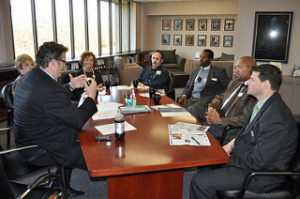 The board of directors of a nonprofit arts organization can and should play an important role in planning for and adopting community engagement as a crucial mission strategy. There is a tendency on the part of some (I have been guilty of this myself) to view the board as an obstacle to be overcome in this work. Yet the board’s potential as a resource for furthering the work of community engagement is considerable and we owe it to ourselves to find productive means of tapping it.
The board of directors of a nonprofit arts organization can and should play an important role in planning for and adopting community engagement as a crucial mission strategy. There is a tendency on the part of some (I have been guilty of this myself) to view the board as an obstacle to be overcome in this work. Yet the board’s potential as a resource for furthering the work of community engagement is considerable and we owe it to ourselves to find productive means of tapping it.
Basic Board Governance
However, the board’s potential for supporting community engagement can be limited if it does not have a clear understanding of and commitment to its more general roles and responsibilities. Boards certainly have a fiduciary responsibility, including ensuring (through participation in fundraising) that the organization has the necessary financial resources. They also have more wide-ranging internal responsibility for the health and welfare of the organization (e.g., maintaining faithfulness to mission, ensuring adherence to laws and regulations, and setting values and vision) as well as external responsibility to make certain the organization furthers the public good.
Unfortunately, too many boards are not aware of these (and many other) responsibilities and are thus ineffective in supporting the work of the organization. In some senses this should not be surprising. Outside the nonprofit world, there is very little understanding of the nature and function of 501(c)(3) organizations. As a result, few people come to nonprofit board service with a clear view of the nature of the work. Further, in an effort to secure board members, expectations are sometimes minimized while training is limited or haphazard. And for too many, board service consists of boring meetings that have little purpose or meaning and of tasks that are not challenging or interesting. This can be made worse by a chief executive’s lack of enthusiasm for the board’s input.
Since boards are a required fact of nonprofit life, it is in the interest of the organization to take advantage of their potential. The keys to doing so are effective recruitment and training processes; creation of a culture in which meetings are productive, meaningful, and even fun; and establishment of a mechanism for board evaluation–annual evaluation of the board as a whole and of members individually.
A board can participate in the development and implementation of an arts organization’s community engagement plan without being a fully functioning board. However, the chances of success in doing so are limited to its overall level of competence.
Status Quo
Board members serve arts organization because they like things the way they are. While, on reflection, this seems obvious, it is often a surprise to people that boards are not anxious to embrace change. This is not simply a reflection of the inherent conservatism of institutions; it is a manifestation of the fact that individual members do not, for themselves, see a need for change. Acknowledging this at the outset will help in developing a plan for educating the board about the need for and value of community engagement.
Beyond Buy-In
Some community engagement activists hope that, at best, the board will not actively oppose community-oriented planning and programs. Given the importance of the board’s role in the organization and the forms of significant support it can provide, I now believe that the board “not standing in the way” is far too low a goal. We need to work with our boards to develop in them enthusiasm for the relevance, vibrancy, and sustainability that community engagement can offer.
Board as Resource Engines
Certainly, boards of directors have long been seen as vehicles for providing financial support. They have also been understood to be valuable for the power connections (political, corporate, social) they have. However, in engaging with communities with which an organization has little history and few personal relationships, individuals who have community connections with the groups the organization is trying to reach are priceless assets. Not infrequently those communities have only vague (or sometimes even negative) impressions of the arts organization. A board member with “street cred” can provide a foundation on which trust can be built between the organization and the community. There is no amount of money that can accomplish that; it’s a resource as least as valuable as a large donation. So, when an organization commits to engagement, consideration should be given to recruiting board members who are passionate about the art and who are respected by the communities the organization is seeking to reach.
Next time: Getting to Yes and the Board as Partner in Community Engagement
Engage!
Doug
Photo: ![]()
![]() Some rights reserved by Michigan Municipal League (MML)
Some rights reserved by Michigan Municipal League (MML)
